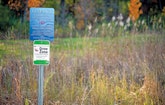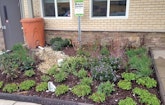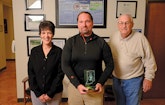
Green infrastructure and low-impact development doesn’t end with the permitting process. One of the keys to success is making sure the infrastructure is properly maintained.
Interested in Stormwater?
Get Stormwater articles, news and videos right in your inbox! Sign up now.
Stormwater + Get AlertsIf a McDonald’s-size restaurant wanted to build a new location in Merrillville, Indiana, it would first need to pass a variety of creative stormwater permit requirements.
That’s because Merrillville doesn’t just have progressive stormwater management, it rewrote the playbook.
Amid ever-increasing national focus on stormwater management, Merrillville — described by Matt Lake, executive director of the Merrillville Stormwater Utility, as a “middle-class” municipality — has taken a bold stance by requiring low-impact methods and green infrastructure for new developments through a town stormwater ordinance.
This wasn’t a self-serving endeavor, though. From the beginning, Merrillville designed its program to be a standard that any other municipality across the nation could model for its own stormwater management.
“The intent of this particular effort is so that other communities can adapt and look at what we’re doing and implement these requirements for their own utilities,” Lake says. “Part of the concept here is to serve as an example of how to successfully incorporate green infrastructure, low-impact development, which includes recycled materials as part of your stormwater infrastructure.”
Rewriting the playbook
Stormwater permits are required for any new development with an acre or more of land disturbance, and Merrillville’s new ordinance requires low-impact development for every stormwater permit that is approved.
For reference, in its franchise FAQ webpage, McDonald’s puts an ideal site at around 50,000 square feet — just over 1 acre. That means any new business of a McDonald’s proportion or larger would require a stormwater permit.
“It’s not something that we incentivize — it is required,” Lake says. “Requiring low-impact development is a progressive approach. Some communities will offer incentives for green practices. As part of our ordinance, you will not receive a stormwater permit unless everything is reviewed and approved by our department.”
As part of the approval process, Merrillville has a four-page checklist that includes various green infrastructure options and low-impact-development best management practices, each worth a certain number of points. Approval requires at least 100 low-impact-development points per acre of development with at least three different BMPs.
“If another community wants to adopt the same requirements and scale it up, they can. They could pass an ordinance that requires 200 points for every acre of development or 300,” Lake says. “We felt that 100 was a very modest way to incorporate these low-impact-development practices. We didn’t want to hinder economic development — we wanted to promote and enhance it.”
The low-impact-development options include features like rain gardens, pervious hardscapes, vegetative buffer zones, infiltration basins, aesthetically pleasing landscaping and hydrocarbon filters.
“The biggest pollutant by volume during construction is going to be sediment,” Lake says. “We ensure temporary erosion and sediment control BMPs are installed and maintained to minimize pollutants from migrating into the catch basins or offsite in any way which could negatively impact the receiving waters. After construction is completed, the low-impact-development BMPs will help capture the ‘first flush’ pollutants from the site during the post-construction phase. Many of these post-construction BMPs incorporate infiltration strategies and vegetation, which utilize phytoremediation to metabolize and degrade organic pollutants or toxic heavy metals.”
“We ensure that all BMPs are installed and performing properly by those responsible,” Lake says. “These practices have to be inspected and enforced through our stormwater ordinance.”
Becoming a green leader
With a population of approximately 35,000 on the outskirts of Chicago, Merrillville is within the Lake Michigan watershed, so preventing pollution in the midsize suburbia is also protecting one of the world’s largest sources of freshwater.
“We’re trying to mimic predevelopment hydrology as much as possible,” Lake says. “The more stormwater infiltration you have on the site, the less runoff you have, which will minimize downstream impacts and assist with compliance of the EPA’s Clean Water Act.”
The town has a 20-year stormwater master plan that identifies $25 million in infrastructure improvements for flood control and to improve stormwater quality. Beyond the new stormwater ordinance and permit requirements on private developments, the stormwater utility has also made a big change when it comes to internal projects, incorporating recycled pipe as a standard bid requirement.
Despite being a young town only established in 1971, it has older infrastructure with predominantly corrugated metal pipe that was installed as many neighborhoods were developed before incorporation.
“The older corrugated metal pipes are rotting away,” Lake says. “Now we’re using more sustainable materials like double-walled corrugated high-density polyethylene that’s 40 percent recycled material and has a 100-year service life.”
Continuous upgrades are ongoing as the utility works to replace and maintain over 800,000 feet of separated storm sewer on an as-needed basis, and the town has committed to using recycled pipe as applicable when those upgrades are needed.
Recognition well-deserved
It’s not just the common detention ponds, bioswales and rain gardens on the stormwater permit checklist. One innovative alternative that Merrillville has included is an option for developers to use the same recycled HDPE pipe for its projects to meet the low-impact-development requirements.
The effort to include recycled pipe in its stormwater infrastructure earned the utility its second state-level environmental award, the Indiana Governor’s Award for Environmental Excellence in Reuse and Recycling. Previously, Merrillville won a similar Greening the Government award for creating the largest rain garden in the state as part of a green streets project.
“We’ve received awards and a lot of recognition. But it’s not about the awards,” Lake says. “To me, the awards and the recognition are ways to promote these types of practices. If someone reads this and says, ‘We can probably do that for our town or our city,’ then that’s really what we want in order to minimize pollutants within our watersheds. We’re going to keep doing what we do, but we also want to encourage other communities to implement low-impact development to protect our lakes, rivers and streams.”
A never-ending effort
Green infrastructure and low-impact development doesn’t end with the permitting process. It’s a consistent effort, promoting new ideas and methods, adding to available BMPs, and most important, making sure the green infrastructure already in place is properly maintained.
“The follow-up is important, in terms of inspecting areas, and making sure they’re maintained by the owner. That’s a vital component and oftentimes missed when you have plant-based green infrastructure such as rain gardens. If they’re not properly managed, then they look like weed patches — they don’t look like intentional landscaping,” Lake says. “That gives a negative stigma to green infrastructure. That’s an important aspect once you actually incorporate these requirements.”
To that end, having the support and commitment of community leaders is important. It was the progressive mindset of the Merrillville Town Council that inspired Lake to jump ship from a career in consulting.
“We had some key members here who said, ‘We want to do things a little bit differently,’” Lake says. “We want to manage things differently. We want to be the example of what a storm-water utility is, how it’s managed, and what kind of projects they do, and to establish something that’s unique.”
“There’s a strategic, multifaceted approach to incorporating low-impact development and green infrastructure,” he says. “The proper development of any community is vital, and you want to implement what we consider a smart growth approach. Everything has to be designed and planned properly in order to expand and enhance areas for new development as well as redevelopment to minimize our impact to the environment.”











